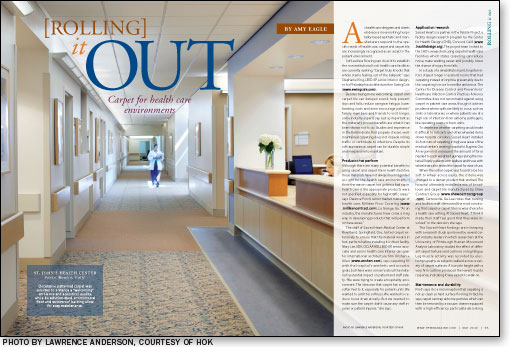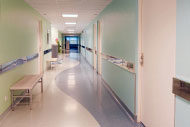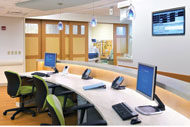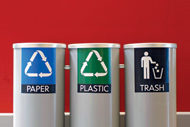Download Rolling it Out Section (PDF)
As health care designers and clients embrace a more inviting, hospitality-based aesthetic and manufacturers respond to the specific needs of health care, carpet and carpet tile are increasingly recognized as an asset to the patient environment.
Soft-surface flooring can do a lot to establish the noninstitutional look health care facilities are currently seeking. "Carpet truly knocks that whole sterile feeling out of the ballpark," says Stephanie King, LEED AP, senior interior designer for Philadelphia architecture firm EwingCole (www.ewingcole.com).
Besides being more welcoming, carpet and carpet tile can dampen sound, help prevent slips and falls, reduce caregiver fatigue, lower heating costs and even encourage patients' family members and friends to visit longer, some industry experts say. Just as important as the material's proven benefits are what it has been shown not to do: Studies and experience in the field indicate that properly chosen, well-maintained carpeting does not impede rolling traffic or contribute to infections. Despite its soft appearance, carpet can be durable, simple and inexpensive to maintain.
Products that perform
Although there are many potential benefits to using carpet and carpet tile in health facilities, these materials have not always been regarded as right for the health care environment. "I think the reason carpet has gotten a bad rap in health care is the appropriate products were not specified, especially for high-traffic areas," says Clarence Porch, senior market manager of health care, Milliken Floor Covering (www.millikencontract.com), La Grange, Ga. "As an industry, the manufacturers have come a long way in developing products that will perform in these areas."
The staff of Sacred Heart Medical Center at RiverBend, Springfield, Ore., tested carpet extensively to ensure that the material would, in fact, perform before installing it in their facility. Mary Lee, IIDA, CID, AAHID, LEED AP, senior associate and senior health care interior designer for international architecture firm Anshen + Allen (www.anshen.com), says carpeting fit with the hospital's aesthetic and acoustic goals, but there were concerns about the material's potential impact on patient and staff safety. "We were trying to create a hospitality environment. The idea was that carpet has a much softer feel to it, especially for patient units. We wanted to add this softness. We wanted to reduce noise dramatically. But we wanted to make sure the carpet didn't cause any staff injuries or patient injuries," she says.
Application research
Sacred Heart is a partner in the Pebble Project, a facility design research program by the Center for Health Design (CHD), Concord, Calif. (www.healthdesign.org). The project team looked to the CHD's research on using carpet in health care facilities, which states carpeting can reduce noise, make walking easier and possibly lower the chance of injury from falls.
In a study of a rehabilitation unit, hospital visitors stayed longer in patient rooms that had carpeting instead of vinyl tile, presumably due to the carpeting's more homelike ambience. The Center for Disease Control and Preventions' Healthcare Infection Control Practices Advisory Committee does not recommend against using carpet in patient care areas, though it advises prudence where spills are likely to occur, such as sinks or laboratories, or where patients are at a high risk of infection from airborne pathogens, like operating rooms or burn units.
To determine whether carpeting would make it difficult to roll carts and other wheeled items down hospital corridors, Sacred Heart installed 20-foot runs of carpeting in high-use areas of the medical center's existing hospital in Eugene, Ore. An ergonomist measured the amount of force needed to push weighted gurneys along the material. Elderly patients with walkers and those with wheelchairs also tested the carpet for ease of use.
When the initial carpet was found to be too soft to wheel across easily, the criteria was changed to a denser product that worked. The hospital ultimately installed a mix of broadloom and carpet tile manufactured by Shaw Contract Group (www.shawcontractgroup.com), Cartersville, Ga. Lee notes that nursing and facilities staff often need the most convincing that carpet or carpet tile is a wise choice for a health care setting. At Sacred Heart, "I think it made their staff feel good that they were involved" in the decision, she says.
The Sacred Heart findings are in keeping with a research study sponsored by several carpet industry leaders in which researchers at the University of Pittsburgh Human Movement Analysis Laboratory studied the effect of different carpet textures and cushions on leg fatigue. Leg muscle activity was recorded by electromyography as subjects walked across a variety of carpet surfaces. A low pile height with a very firm cushion produced the lowest muscle response, indicating it was easiest to walk on.
Maintenance and durability
Porch says it is a misconception that carpeting is not as clean as hard surface flooring. In fact, he says, carpet can trap airborne particles, which can then be removed by a vacuum cleaner equipped with a high-efficiency particulate-absorbing (HEPA) filter. The maintenance cost per square foot also is less than that of hard surface floors, he adds.
Thermoplastic backings create a moisture barrier that prevents spills on the surface of a carpet from flowing through the backing and into the subfloor.
Welded seams, like those on the Powerbond product from Tandus Flooring (www.tandus.com), Dalton, Ga., form an even more resistant barrier. Powerbond is essentially a resilient sheet flooring product with a surface that looks like carpet, which combines cushioning with wall-to-wall moisture barrier protection.
Carpet and carpet tile take few chemicals and little water or energy to maintain. According to the Carpet & Rug Institute (www.carpet-rug.org), Dalton, Ga., carpet's thermal resistance retains warm air, which can conserve energy used for heating. Ridley Kinsey, vice president of sales, health care markets, at Tandus Flooring, says that over a 20-year life of a floor, 20 to 30 percent of the cost of ownership is in the original materials and installation, with the rest going toward maintenance, repair and replacement. With lower maintenance and less downtime for replacement, durable carpeting can provide long-term savings.
"We've had some installations in schools, hospitals and airports that have been installed and successfully performing for over 30 years. You have to have a product that's engineered for the appropriate purpose. If you have that, it's going to lower your operational and ownership costs and make life better for people," he says.






